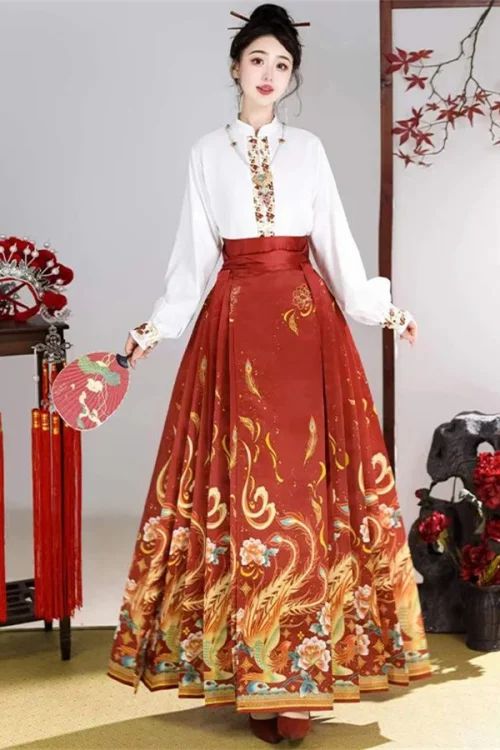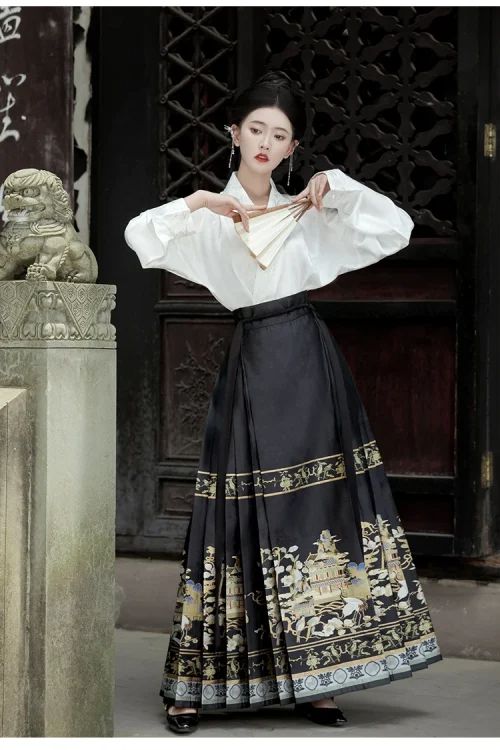The Ma Mian Qun: A Symbol of Imperial Power and Authority
The Ma Mian Qun, an iconic garment in traditional Chinese attire, holds profound cultural significance that transcends its aesthetic appeal. As a symbol of imperial power and authority, it has played a pivotal role in shaping the social and political landscape of China for centuries.

Historical Origins
The Ma Mian Qun, literally meaning “马面裙,” is characterized by its distinctive shape and intricate embroidery. Its origins can be traced back to the Han dynasty, where it was worn by high-ranking officials as a ceremonial robe. Over time, it evolved into a symbol of imperial authority, reserved exclusively for the emperor and his immediate family.
Symbolic Design
The Ma Mian Qun’s design is meticulously crafted to convey its symbolic meaning. The horse-face shape represents strength and virility, while the elaborate embroidery depicts auspicious motifs such as dragons, phoenixes, and clouds. These motifs symbolize the emperor’s divine mandate to rule and his connection to the celestial realm.
Social Stratification
Beyond its ceremonial significance, the Ma Mian Qun also served as a means of social stratification. During the Ming and Qing dynasties, the use of certain colors and patterns was strictly regulated, with different ranks of officials wearing specific variations of the garment. This elaborate system of dress codes reinforced the hierarchical structure of Chinese society.
Cultural Relevance Today
The Ma Mian Qun’s cultural significance extends beyond its historical context. In contemporary China, it remains a symbol of national pride and cultural heritage. It is often featured in traditional festivals, operas, and other cultural events, evoking a sense of nostalgia and connection to the past.
Artistic Inspiration
Moreover, the Ma Mian Qun has inspired countless works of art and literature. Its unique shape and symbolism have captured the imagination of artists and writers, who have used it as a motif to explore themes of power, authority, and cultural identity.
In conclusion, the Ma Mian Qun is not merely a garment but a profound symbol of imperial power and authority in traditional Chinese attire. Its intricate design, historical significance, and enduring cultural relevance make it a testament to the rich tapestry of Chinese history and culture. As a symbol of national pride and cultural heritage, the Ma Mian Qun continues to inspire and captivate generations of Chinese people.
The Ma Mian Qun: A Reflection of Chinese Social Hierarchy
The Ma Mian Qun, an iconic garment in traditional Chinese attire, holds profound cultural significance that transcends its aesthetic appeal. It embodies the intricate social hierarchy that permeated Chinese society for centuries.

Distinctive Characteristics
The Ma Mian Qun, literally meaning “horse-face skirt,” is characterized by its distinctive pleated front panel and elaborate embroidery. Its origins can be traced back to the Ming dynasty (1368-1644), when it became a symbol of status and rank. The length, width, and ornamentation of the skirt varied according to the wearer’s social position.
Symbol of Exalted Status
For imperial consorts, the Ma Mian Qun was a symbol of their exalted status. The skirts were adorned with intricate embroidery depicting auspicious motifs such as dragons, phoenixes, and flowers. The length and width of the skirt were also indicative of their rank, with the empress wearing the longest and widest skirt.
Marking Social Standing
For women of the upper classes, the Ma Mian Qun served as a marker of their social standing. The skirts were made from luxurious fabrics such as silk and brocade, and the embroidery was often more elaborate than that found on the skirts of commoners. The length and width of the skirt also varied according to the wearer’s rank within the upper classes.
Modesty in Lower Classes
For women of the lower classes, the Ma Mian Qun was a more modest garment. It was typically made from simpler fabrics such as cotton or linen, and the embroidery was less elaborate. The length and width of the skirt were also shorter and narrower than those of the upper classes.
Reinforcing Social Order
The Ma Mian Qun not only reflected social hierarchy but also played a role in shaping it. By visually distinguishing between different social classes, the garment reinforced the existing social order and discouraged social mobility. It served as a constant reminder of one’s place in society and the boundaries that could not be crossed.
Modern Symbolism
In modern China, the Ma Mian Qun has become a symbol of cultural heritage and national pride. It is often worn at traditional festivals and cultural events, and its intricate embroidery and elegant design continue to captivate audiences worldwide. While the social hierarchy that it once symbolized has largely disappeared, the Ma Mian Qun remains a testament to the rich cultural traditions of China.
The Ma Mian Qun: A Canvas for Artistic Expression and Cultural Identity
The Ma Mian Qun, an iconic garment in traditional Chinese attire, holds profound cultural significance that transcends its aesthetic appeal. Its origins can be traced back to the Ming dynasty, where it was initially worn by women of the imperial court. Over time, it evolved into a symbol of elegance and refinement, becoming a staple in the wardrobes of women from all walks of life.

Distinctive Features
The Ma Mian Qun is characterized by its distinctive horse-face-shaped skirt, which is believed to bring good fortune and ward off evil spirits. The skirt is typically made of silk or satin and is adorned with intricate embroidery, often depicting auspicious motifs such as dragons, phoenixes, and flowers. The bodice, on the other hand, is usually made of a contrasting fabric and features a low neckline and long, flowing sleeves.
Artistic Expression
Beyond its aesthetic value, the Ma Mian Qun serves as a canvas for artistic expression. The embroidery on the skirt and bodice is often meticulously crafted by skilled artisans, who use a variety of stitches and techniques to create vibrant and lifelike designs. These designs not only enhance the beauty of the garment but also convey cultural narratives and symbolism.
Symbolic Motifs
For instance, the peony, a common motif in Ma Mian Qun embroidery, represents wealth and prosperity. The lotus, on the other hand, symbolizes purity and enlightenment. By incorporating these motifs into the garment, the wearer expresses their hopes and aspirations for a fortunate and fulfilling life.
Cultural Identity
Moreover, the Ma Mian Qun has played a significant role in shaping Chinese cultural identity. It has been featured in countless works of art, literature, and film, becoming an enduring symbol of Chinese tradition and heritage. Its popularity has also extended beyond China, with designers around the world incorporating elements of the Ma Mian Qun into their contemporary creations.
结论
In conclusion, the Ma Mian Qun is not merely a garment but a cultural artifact that embodies the artistic prowess and cultural identity of China. Its intricate embroidery, auspicious motifs, and enduring popularity have made it an enduring symbol of elegance, refinement, and national pride. As a testament to its cultural significance, the Ma Mian Qun continues to inspire and captivate people around the world, serving as a bridge between the past and the present.
